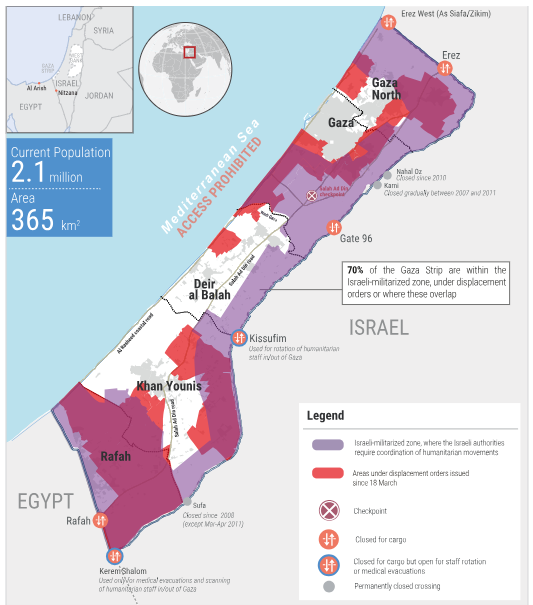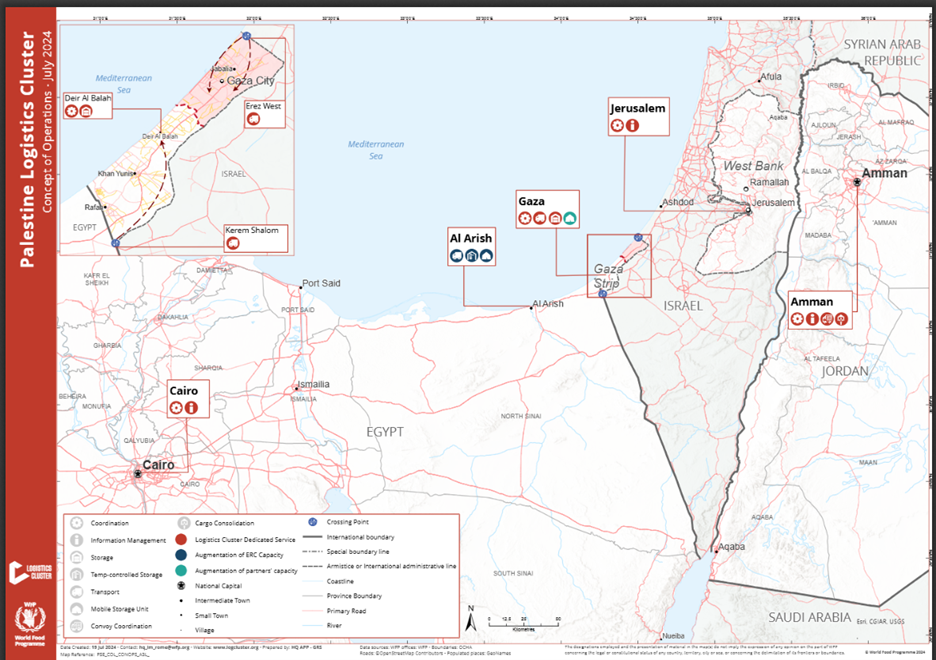The estimated population of Gaza remains above 2 million. Some suggest up to 2.4 million people could still be resident in the roughly 50 miles long by 25 miles deep strip extending along the Mediterranean between Egypt and Israel.
Since the October 7, 2023 Hamas attacks on Israel, flows of food, fuel, and other essentials into Gaza have been disrupted, diminished, and often nearly non-existent as a result of military operations. This has resulted in wide-spread hunger and malnutrition with related morbidity and death (here). In the last two weeks a fragile ceasefire has allowed for increased flows and urgent efforts to surge flows. In the last three to five days flows have increased from a trickle to an intermittent stream, still insufficient for the population.
Upstream sources of food and fuel have long exceeded available flow capacity. Substantial food/fuel stocks and rolling-stock to deliver are available within fifty miles (e.g., the Egyptian port of Al Arish is roughly 30 miles west. Metro Jerusalem is 50 miles Northeast. See second map below).
On October 9 — leaning into the emergent ceasefire agreement — Tom Fletcher, United Nations Under-Secretary-General for Humanitarian Affairs and Emergency Relief Coordinator, noted the following priorities:
…we will scale up the provision of food across Gaza to reach 2.1 million people who need food aid and around 500,000 people who need nutrition. Famine must be reverted in areas where it has taken hold and prevented in others. So we will be distributing in-kind rations. We’ll be supporting bakeries, community kitchens. We’ll be supporting herders and fishers in restoring their livelihoods. And we will be providing cash for 200,000 families to cover basic food needs and bolster their ability to cope, and also to give them their sense of – and this is so important – dignity and agency by choosing their own food from the markets… we’ll increase nutrition screening, and we’ll provide nutrition supplies, including high-energy, nutrient-dense food items for the most vulnerable groups, including pregnant and breastfeeding women and children and adolescents. (More and more)
While significant upstream supplies have always been available close-by, food depots in Gaza have seldom had much beyond a Just-In-Time flow capacity due to restricted inbound and outbound flows. But the most serious flow impediment has been often absent midstream to downstream flows. Lack of secure points-of-distribution accessible to the population and inaccessible “last mile” supply routes have constrained discharge of whatever food, fuel, and other resources made it across the border into Gaza (see first map below).
With the ceasefire still holding, progress on downstream discharge capacity is improving. For example, the UN Office for the Coordination of Humanitarian Affairs (OCHA) reports that:
… as of Sunday (October 19), food parcels were being distributed at over two dozen locations in Deir al Balah and Khan Younis, reaching more than 15,000 households there. These food parcels contain various nutritious food items, including rice, lentils, beans, chickpea paste, tomato paste and fortified sunflower oil. Partners are working to expand the number of distribution points to ensure that people can access food closer to where they live. Also on Sunday, 21 partners prepared and delivered some 944,000 meals through 178 community kitchens. This is an increase of some 286,000 daily meals in about three weeks. Sunday’s total included 69,000 meals from 13 kitchens in the north, as well as 875,000 meals from 165 kitchens in the south and central areas.
The downstream infrastructure necessary to surge flows will take time to re-establish — especially in a context where much of the built environment has been destroyed (here). There is also continuing concern regarding non-structural limits on inbound flows to Gaza (here and here).
Currently intense demand is widely dispersed. Supply capacity remains concentrated and too static to find, much less fulfill, demand. Downstream flows are spotty, irregular, and sparse. Push is not anywhere close to matching pull velocity. A Civil Military Coordination Center has been created to monitor and facilitate improved push velocity (here and here).
Much more still to come… we can hope.

The map above reflects pre-ceasefire (May 2025) conditions. Cargo crossings remain limited to locations noted.

The map above indicates principal upstream sources of flow ala 2024. These remain mostly accurate in October 2025. Not all Gaza crossings and discharge possibilities shown have reopened since the ceasefire.